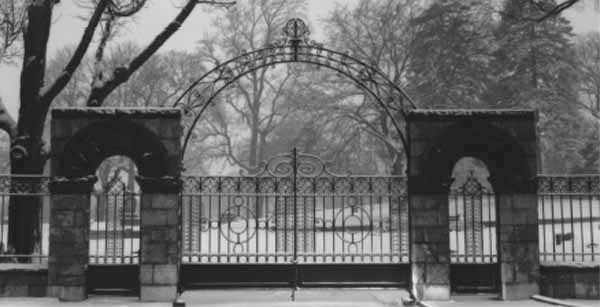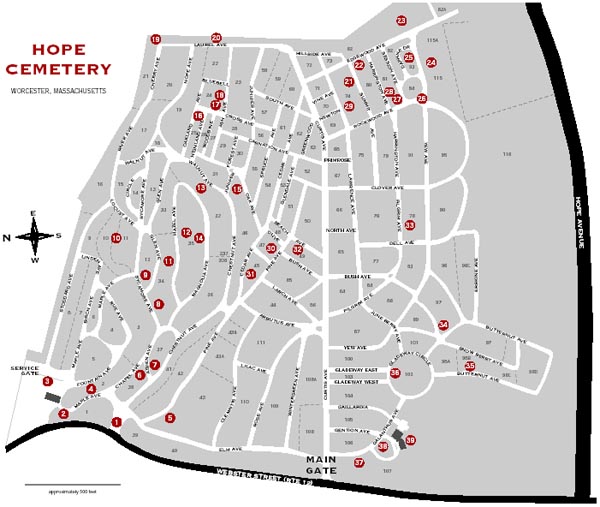About Hope Cemetery

 Hope Cemetery, dedicated in 1852, is Worcester s second garden cemetery, born of the rural cemetery movement inspired by romantic perceptions of nature, art and the themes of death, as well as by the realities of civic development and identity. A city-owned cemetery, Hope is the last resting place of the people who shaped Worcester industrialists and workers, inventors and mechanics, men and women people of all ages, races and beliefs. Here a visitor can contemplate monuments and statues while strolling through a setting of fine trees and plantings.
Hope Cemetery, dedicated in 1852, is Worcester s second garden cemetery, born of the rural cemetery movement inspired by romantic perceptions of nature, art and the themes of death, as well as by the realities of civic development and identity. A city-owned cemetery, Hope is the last resting place of the people who shaped Worcester industrialists and workers, inventors and mechanics, men and women people of all ages, races and beliefs. Here a visitor can contemplate monuments and statues while strolling through a setting of fine trees and plantings.
As early as the late 1840s, the need for a new civic cemetery was under discussion as older burial grounds either filled up or fell victim to neglect. In nothing, perhaps, is the taste of a community more visible, than in the care which it bestows upon the resting place of the dead, commented one politician. Hope Cemetery replaced as many as six earlier burial grounds that were overwhelmed by the growing city. By the end of the century remains from Mechanic Street, Tatman and Pine Meadow cemeteries were reinterred at Hope, and in the 1960s graves were moved here from Worcester Common.
Situated near the top of Webster Street, Hope Cemetery is a carefully planned cohesive landscape whose overall character is defined by the interrelationship of features within. The siting of the roads and paths, trees and shrubs, as well as the placement and scale of mausoleums, all reflect a sense of design that for a century and a half has continued to make this a beautiful spot. The cemetery occupies approximately 168 acres of rolling land between Kettle Brook to the south, Curtis Pond to the west, and Middle River to the north. The terrain has been carefully worked to create views and vistas that enhance the natural beauty of the site.
 Entry through the 1917 Nixon Gates (once used as the main entrance) brings visitors up a slight grade past the impressive memorials and mausoleums north of the entrance. There is a broad view of the southwest quarter of the cemetery along the granite wall, which sweeps down to the lower gates currently in use. The size and balance of Hope Cemetery take full advantage of the hilly terrain.
Entry through the 1917 Nixon Gates (once used as the main entrance) brings visitors up a slight grade past the impressive memorials and mausoleums north of the entrance. There is a broad view of the southwest quarter of the cemetery along the granite wall, which sweeps down to the lower gates currently in use. The size and balance of Hope Cemetery take full advantage of the hilly terrain.
A recent Horticultural Survey and Tree Inventory underwritten by the Friends of Hope Cemetery documents a number of specimen trees as part of the high degree of embellishment. The most exceptional examples are three champion European Beech trees with diameters of 55 to 59 inches. Other champions include Norway Maples, Red Maples, Sugar Maples, Sweet Birches, Katsuras, Coast White Cedars, White Ash, White Scarlets, and Red Oaks. Many of the roads are named for the trees that flourish in the cemetery.
Any citizen of Worcester has the right to be buried in Hope Cemetery. If the person or the family is unable to pay for burial, space is provided without cost. Grave sites are sold based upon location and size. The marking and decorating of lots are regulated to maintain the beauty and integrity of the cemetery.
In 1998 Hope Cemetery was placed on the National Register of Historic Places. This recognition assists in the preservation of the cemetery as part of the city’s great heritage.
During the past year [1851], the city has made a purchase of a lot of about 50 acres, situated south of New Worcester, for a public cemetery, at a cost of $1855. In the opinion of competent judges, this lot is admirably adapted to the purpose for which it is designed. It is neither too remote from, nor too near to, the city. Its surface is variegated with hills and valleys. It is elevated above the New Worcester stream, which sweeps it upon the north. It is susceptible of a high degree of embellishment. . . . If properly graded and embellished, it would furnish a beautiful spot for the resort of the living, and a resting-place for the dead.
Mayor Peter C. Bacon
Annual Report
January 5, 1852

